Mummy Monday #1: Franklin Expedition Ice Mummies
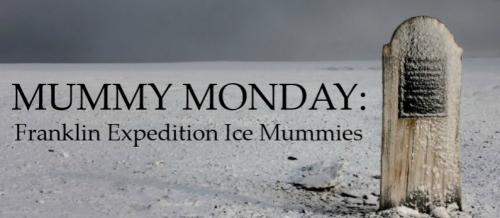
[WARNING: In-depth discussion of human remains along with relevant images, some of which may be disturbing.]
In the electric hustle of the mid-1980s, there weren’t many eyes turned toward the loneliest corners of the Canadian Arctic. It was a forward-momentum period, caught up the 20th century’s mach-speed technological progress and cultural change. In all of this movement, it took something quietly monumental to turn heads toward the past and look, quite literally, into its eyes. The world looked into three 140-year-old graves in permafrost, and found three sets of eyes wearily looking back.
Their names were John Torrington, John Hartnell, and William Braine. In Victorian society, they would have faded into the backdrop of the social tapestry. One was a working-class petty officer, another a former shoemaker that had recently joined the Navy, and the third a private in the Royal Marines. In their world, they were perfectly ordinary—but it was their deaths that made them extraordinary. In time, they would be called the Beechey Island or Franklin Expedition mummies, and would become instrumental in helping to solve one of the greatest mysteries in exploration history.
In this first Mummy Monday, we’ll explore the lives and deaths of the Beechey Island trio, as well as their forensic results, cultural impact, and a further look into their unique process of mummification.
The Franklin Expedition
In international news, the Franklin Expedition has been something of a hot topic as of late. New artifacts, incredible discoveries, and potential vacation routes; not to mention a critically-acclaimed television series in 2018! Its impact is present in multiple facets, but it can be hard to gain a full scope of what it was and why it matters.
The quickest, dirtiest summary is this: in 1845, the British Admiralty sent two well-fitted bomb vessels—HMS Erebus and HMS Terror—into the Arctic to ply the waters for the fabled Northwest Passage. It got very, very cold to the point that the land was inescapable and all 129 men aboard succumbed to any number of horrible fates—disease, starvation, exposure, and possibly even more violent ends. Say what you will about ominous-sounding names for these ships and risking fate, but the results were horrifying across the board. Scottish explorer John Rae even made discoveries of cannibalism among the wreckage of what was to be the most promising of Her Majesty’s exploration attempts, much to the public’s disgust, chagrin, and fascination.
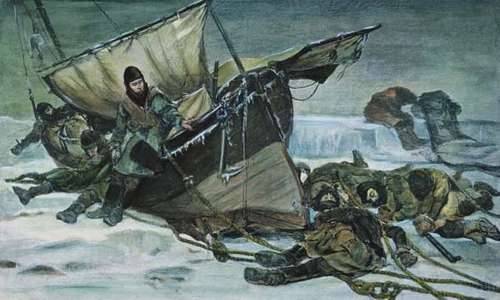
There is, of course, so much more to the story than just a few quick notes about the horrors nature can inflict and the question of imperialistic hubris. One peek into the fae realm of Franklin-related academia is a little bit mind-boggling, and there have been plenty of glorious attempts to parse it all out. The sources range from contemporary to theoretical, and as much as people agree or disagree, the siren call of Frankliniana can be hard to resist.
So where the hell do you start?
For the sake of Mummy Monday, we’re starting where most of Franklin’s rescue attempts did: Beechey Island.
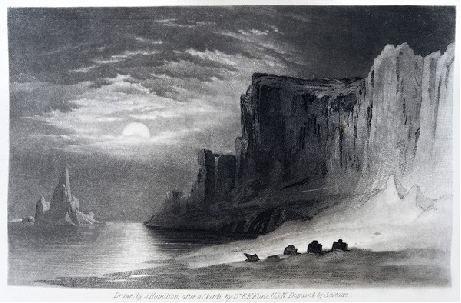
Beechey Island
It’s a forbidding corner of the Canadian Arctic, even today. Nestled at the foot of Devon Island in the Wellington Channel of modern-day Nunavut, it can appear either unremarkable or dread-inspiring, depending on the day and the weather. Its nearest inhabited neighbor is the town of Resolute, although its name in Inuktitut gives a better sense of the landscape: Qausuittuq or ‘the place with no dawn’.
Most explorers tracing the steps of Franklin stop in Resolute to charter passage to Beechey Island. Although there are animals living near the area (different species of sea bird and the iconic polar bear), the tourism sector of Beechey Island is profoundly dedicated to the quiet contemplation of the remains of Franklin’s first winter camp. Scattered across the stones are broken pieces of wood and rusted rings of old Goldner’s cans. To this day, it’s possible to see the ongoing decay of history in the shadow of memorials left behind by past searchers.
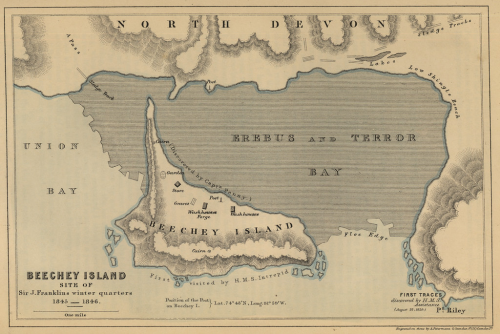
And then there are the graves.
The original headboards are now stored at the Prince of Wales Northern Heritage Centre in Yellowknife. Weather-resistant replacements still bear the same messages as the originals, each recalling the names, statuses, and death dates of three of Franklin’s men. Two graves, from Erebus, have ominous-sounding Bible verses tacked on to the epitaphs.
There is a fourth grave belonging to Thomas Morgan, an able-bodied seaman (AB) from the HMS North Star who died during a search for Franklin in 1854. Morgan is entombed alongside his Erebus and Terror predecessors, but he has not yet been exhumed.
And yeah, exhumations. That’s what we’re here for on Mummy Monday, after all!
In 1984, Dr. Owen Beattie of the University of Alberta led a crew of researchers and scientists to this lonely point in the Arctic Circle. At the time, he was entertaining the possibility of lead poisoning being a factor in the ultimate fate of the Expedition. Part of this consideration came from the bajillion cans littered across the extensive trail, each soldered shut with clumps of lead that Beattie believed leached into the food the men were eating. Beattie had good reason to pursue this theory! His belief was that the acidic nature of some of the canned food would have caused a breakdown in the lead solder, causing the food to become contaminated. Even without this theory, he wouldn’t have been off the mark at all. Later discoveries contemporary to the Expedition found other cans manufactured and sealed by Stephen Goldner to have gone completely rancid. That, outside of the lead-poisoning theory, certainly wouldn’t have helped matters. Another explanation pointed to the lead piping installed in the ships themselves. Would water passing through these pipes have poisoned the men in the process of drinking or breathing? What about lead-based paints, often needing to be applied throughout the year in new coats, and condensation to follow on steam-powered and heated ships? What about the nature of being a person in the Victorian era in the first place? You were probably about as leaden as a musket ball.
So Beattie made his trek north, intending to exhume John Torrington and crossing his fingers on the possibility of exhuming John Hartnell. People knew these men had died young, even by Victorian standards. Torrington was 20 years old, Hartnell 25, and William Braine 32. Torrington and Hartnell died within three days of one another at the beginning of January, 1846. Braine died only a few months later in April. If Beattie’s theory was correct, then lead may have played a part in why these men were dropping like flies after only a few months on the Expedition.
As detailed in his book, Frozen in Time, great pains were taken to get permits and carefully exhume John Torrington. It was far from easy. Beattie and his team had to dig, pick, and melt their way through around six feet of gravel and cement-hard permafrost. They had entertained the possibility that permafrost might have preserved the bodies; they had no idea how right they were.
After uncovering one black coffin, edged in decorative white tape and bearing brass handles (one was still in the ‘up’ position), they carefully melted through layers of ice until one researcher reached a piece of blue wool cloth. As gently as possible, he tugged aside the cloth and revealed the frozen face of John Torrington.

Petty Officer and Lead Stoker John Torrington seemed to wearily peer back at the researchers. And he was, in fact, peering. Torrington’s body had been almost perfectly preserved, including his eyes, other soft tissue, and cartilage. His striking appearance startled the researchers, understandably. They had been expecting some degree of preservation, but not this.
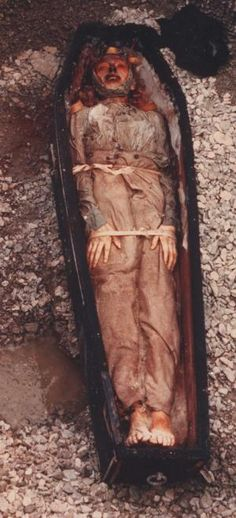
He was only 5′4″ (163 cm) and weighed just under 88 lbs (40 kg). Dressed simply in clothing that showed exactly how underweight he was at the time of his death, something about his appearance struck some emotional chord with the team. In Frozen in Time, Beattie quietly makes the comment that Torrington looked, “just unconscious” and “anything but grotesque”.
“The expression on his thin face, with its pouting mouth and half-closed eyes gazing through delicate, light-brown eyelashes, was peaceful. His nose and forehead, in contrast to the natural skin colour of the rest of his face, were darkened by contact with the blue-wool coffin covering. This shadowed the face, accentuating the softness of its appearance. The tragedy of Torrington’s young death was as apparent to the researchers as it must have been to his shipmates 138 years before.” (pp. 171-172)
His jaw was bound shut with a polka-dot kerchief (think Jacob Marley) and his limbs were tied together using cotton wrapping. Researchers made note of his hands, which showed some of the greatest degree of his preservation.
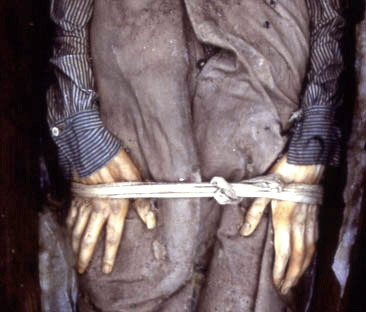
What was even more incredible was the full degree of flexibility his body retained. Beattie and a team member lifted Torrington from his coffin for his full autopsy, and as they did so, Torrington’s head rolled onto Beattie’s left shoulder. Beattie also noted how light and limp Torrington was more or less like lifting an unconscious child.
Samples were taken of Torrington’s hair, nails, organs, and brain. The fact that these samples could be taken at all was incredible, especially in their state of preservation. After this was done, Torrington was reburied with the utmost respect and the expectation that the grave itself would refreeze from encroaching water. Not only would Torrington be preserved physically, but his photos were about to preserve his memory in ways no one could really expect.
But, of course, he was just one of three.
John Hartnell and the ‘Face of Death’
Researchers literally brushed the surface of Hartnell’s grave in 1984 as time constraints prevented them from doing a full exhumation. They had enough time to do an initial dig and uncover part of him, which was enough to sate their curiosity for the moment. Undoubtedly, they still thought of Torrington’s repose and his more delicate features.
They weren’t really prepared for, uh…
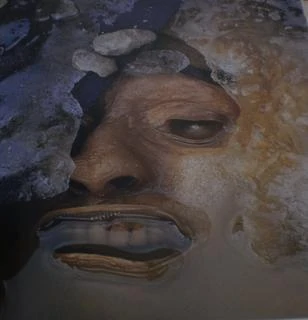
Probably the most pissed-off mummy known to man. At least, that’s what he looked like. One researcher, Walt Kowal, might have summed it up best when he remarked, “This guy is spooky. The quintessential pirate. This guy is frightening.” (p. 184)
He wasn’t entirely wrong. Something about John Hartnell’s face seemed angry, and it didn’t help matters that his right eye was missing. As the water drained away, John Hartnell grimaced where Torrington had just seemed to passively observe. In time, the entire figure of AB John Hartnell emerged.

Dark-haired and hazel-eyed, Hartnell appeared to be something of Torrington’s opposite. Both men had the distinct features of mummification-in-ice, such as the receded and pursed lips from the water and the half-open eyes. That was where the similarities ended, however. Hartnell was bundled up in a blanket and shroud with his head resting on a pillow, where Torrington laid on a bed of sawdust (often mistaken in pictures as his hair). Pains had been taken to make Hartnell look presentable; his hair was combed and cut, his nails trimmed, and his body dressed in three shirts and a hat (no pants, though).
The question remained almost tangible: why were these men so different?
As the researchers reburied the remains and returned to Alberta to pore over lab results, so to am I going to take a step back and look at their lives in detail.
The Men Behind the Mummies
There’s not much I can say about Torrington that hasn’t been beautifully covered in magnificent detail by my Torrington research counterpart, @entwinedmoon. Her Torrington research series absolutely floored me with its depth and clear passion for the subject! Literally everything about his life, death, and afterlife is covered in there, so I can’t recommend it enough. And I absolutely agree with the sentiment that tracking Torrington down is like cryptid-hunting. Oof.
What I can say in a pale shadow of entwinedmoon’s work is that John Shaw Torrington was born around 1825 in the city of Manchester, making him around 19 or 20 at the time of his death. He hadn’t served in the Navy prior to being assigned as a petty officer on HMS Terror, but his lung tissue showed that he’d definitely been exposed to the amount of smoke expected of both a lead stoker and a Manchester resident (given its Victorian reputation as a pollution-belching beast of a city). Exact details of his life are hard to follow, making him something of a shadowy figure for being so front-facing after his death. Examination of his hands showed that at the time of his death, he probably hadn’t done much work between his illness and the fact the ships were frozen in and thus not really needing someone to work their locomotive engines.
And he’d been sick. Really sick.
In the end, it was a combination of tuberculosis and pneumonia that sent John Torrington to his premature grave. He’d been, as discussed, incredibly underweight, but had been well enough to pass a health check in Greenland when some of his comrades had been sent back to England for similar health issues. The when of his illness isn’t known, but it had lingered long enough to thoroughly emaciate him. Had he been sick prior to leaving England and just covered it up? Possibly. Had he been sick but had a flare-up at some point after the health check? Also completely possible.
In short, after his autopsy it became clear that everything about Torrington’s body was at active war against his life. He’d been small in build and had lungs so scarred with smoke and illness that lung tissue adhered to his chest wall. This wasn’t a man destined to live very long.
As opposed to his neighbor.
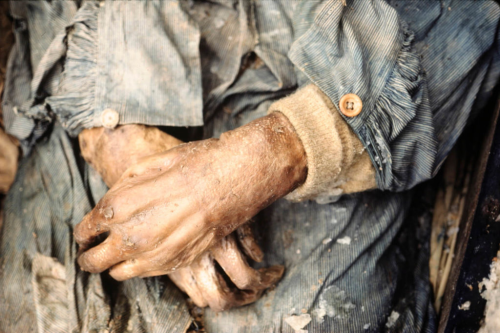
A personal aside, John Hartnell is my favorite. I’ve spent years researching his life, his family, and every detail I can hunt down about him, and it’s taking a lot not to just fly right into overshare mode. I can say that Hartnell’s mummy wears a lot of reminders of his life, along with the life of another one of the Expedition’s non-mummified members.
John Hartnell was born in 1820 in Gillingham, Kent. He was the oldest of five siblings and after the death of his father in 1832, immediately went to work as an apprentice shoemaker. Yeah, not a Navy man or a dockyard worker like his father. He signed his name on a form dedicating his time and effort under one Henry Sarge and went to work crafting footwear. A necrotic right wrist bone tells a story of repetitive movements and damage. Growth arrest lines in his ankle bones say that the 5′11″ (180 cm) Hartnell had actually had his growth stunted around the onset of puberty, possibly owing to malnutrition. However, letters from his mother Sarah and brother Charles paint the image of a close-knit family avid to support one another.
So close-knit, in fact, that John was one of two Hartnells on Erebus. His brother, Thomas, was two years younger than him and accompanied John as an AB. Their names appear beside one another in the muster books (possibly including a cousin, John Strickland) and John was buried in one of Thomas’ shirts, with the initials embroidered on a shirttail.
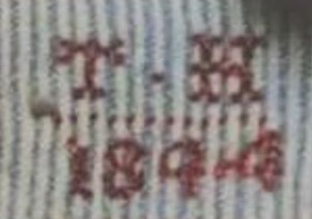
Although no known letters exist from John or Thomas Hartnell, the grave contents alone paint a remarkable picture of family ties in extraordinary conditions.
A new question arose, however. Torrington may have been marked by fate with his illness, but Hartnell had been healthy even past the health check in Greenland. What had happened to him?
For that, we need to go back to Beechey Island in the summer of 1986.
‘Son of a bitch! He’s been autopsied!’
Beattie and his team returned to Beechey Island in June, 1986 with a renewed sense of purpose and, of all things, an x-ray machine. It was set to be the first time such a machine would operate above the Arctic Circle and the team was both eager to try and dreading the worst case scenarios. Results from Torrington encouraged them, as the lab gave the news that Torrington’s hair had showed lead levels far above average, further pointing toward the lead-poisoning theory. Now the researchers were prepared to see if the same held true of John Hartnell and William Braine.
Unfortunately, very little is known of Royal Marine William Braine, aside from the fact that he was a private from Somerset. He’d been married prior to his departure, and seemed to come from a large, poor family. Economic reasons may have led him to join the Royal Marines, and he’d had no choice in where he was set to be assigned. Just as with the rest of the Marines in the Expedition, they were to serve in the Arctic regardless of their choices, and at a regular pay rate as opposed to the regular crew’s double pay. Aside from this, Braine’s life is well-obscured by history at the moment, so I won’t go into his results as much as Hartnell’s which can be correlated with his personal history.
The team re-exhumed John Hartnell after a good deal of difficulty, as shown in this incredible NOVA documentary aired in 1988. In the two years since the last exhumation, very little had changed in Hartnell’s appearance. The main difference was that his remaining eye appeared more sunken, but clearly the ice had done its job in preserving him.
This time, the team cut away his toque and revealed, of all things, a full head of hair.
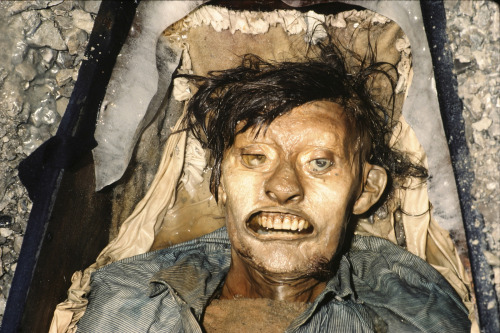
Brian Spenceley, a physics professor at Lakehead University in Thunder Bay, stood in as a photographer during this exhumation. What made his presence remarkable was the fact that he was John and Thomas Hartnell’s great-great nephew. It’s somewhat eerie to see him in the NOVA documentary, juxtaposed with images of Hartnell that are clear enough to show some family resemblances.
Like Torrington, Hartnell was removed from his coffin for a full autopsy. Unlike Torrington, Hartnell was subjected to x-rays which required removal of his clothing. And very much unlike Hartnell, removal of his clothing revealed another detail that, at risk of sounding clickbait-y, shocked the researchers.
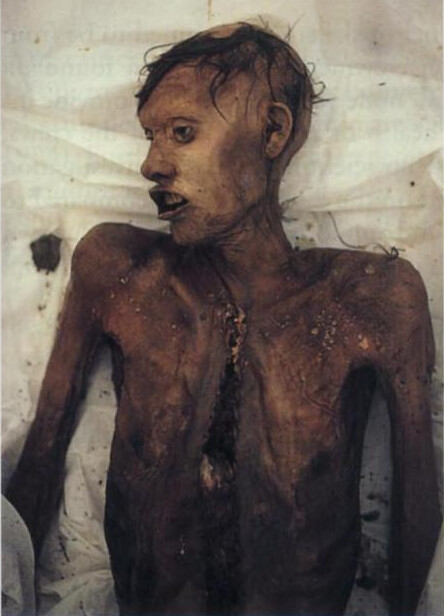
He’d already been autopsied.
Hartnell bore the scars and stitches of an upside-down Y-incision that terminated at his hips rather than his shoulders. It correlated with some initial results of his x-ray which showed a scrambling of organ material, some in places where it shouldn’t have been (his liver in his shoulder, for instance).
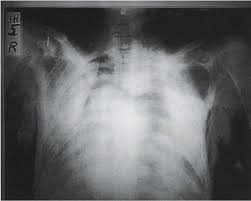
According to Beattie, John Hartnell had been autopsied while still on Erebus, presumably under the hands of assistant surgeon and naturalist Harry D.S. Goodsir. The autopsy appeared hurried, with Hartnell’s chest plate being replaced upside-down as well. Beattie estimated that the entire procedure lasted no more than a half hour. However it had gone, someone had quickly cut out his organs, examined some (such as his heart) in detail at the point of a scalpel, and then shoved the organs back in without a care as to where they went. There are plenty of explanations for the time constraints, including the cold, the threat of disease, and the possible pressure of doing an autopsy under the scrutiny of superstitious sailors and a distraught younger brother. All in all, it gave the team a remarkable chance to observe a Victorian autopsy as they did their own.
As with Torrington, the team took samples of organ, bone, nail, and hair for later analysis. Hartnell’s appearance pointed yet another accusing finger at tuberculosis, but not with the lung damage as sustained in Torrington’s body. It was possible there was something else at work with Hartnell.
Also, a polar bear interfered, leading to one of the best forensic case notes I’ve ever seen.

Once autopsies and x-rays were concluded (the x-ray machine worked fine, provided it was being warmed by a fish tank water heater), Hartnell was wrapped in a linen shroud with his clothes placed in a bag to be buried with him. With Spenceley present at the reburial and the thought that Thomas Hartnell had been at the graveside 140 years prior, the whole situation carried an extra emotional weight. As Spenceley recalled, at the end he felt as though he was burying someone he knew.
Once the grave was replaced as accurately as possible following archaeological diagrams and photographs, the time came to exhume the third mummy, William Braine.
And he didn’t look quite right.

Whereas Torrington and Hartnell had retained something of a lively appearance (loosely, at least), Braine looked well and truly dead. He had clearly decomposed to some degree before the preservation qualities of the permafrost could take effect. His eyes were sunken into his head, his skin wax-like, skull prominent, and body slightly twisted in the coffin. One arm was tucked under his body to make him fit into what seemed to be an ill-fitting coffin that, unlike the other two, was not fitted to his measurements. Even the lid had been shoved down until it pressed against his nose and deformed it slightly. And even worse, the skin of one arm showed rat bites. Obviously, it had taken a good while for poor Braine to actually be buried. Like I said, he was 32 at the time of his death. His body sure doesn’t make him look 32.
His x-rays were far more conclusive in the cause of his death, but less so in the case of his burial. Braine’s spine had been literally twisted by tuberculosis.
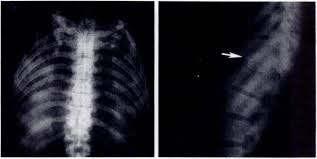
It clearly had more time to wrack his body. He weighed about as much as Torrington had but stood at 6′0″ (181 cm). A theory arose that Braine had possibly died in a sledge group, causing his companions to haul his body back to shore. He had probably been kept in the hold for some time, in accordance with the bite marks and level of decomposition.
Sadly, as said, little is known of Braine’s life. He was illiterate, having made an X mark in the muster records. No letters have been found addressed to him or from any of his siblings. While one cursory biography was written by a possible descendant, not much research has been done to solve the mystery of his life (yet).
Braine was thereafter reburied, and this chapter of the Beechey Island’s saga was nearly done. And yet, the exhumations only provided more questions than answers.
Heavy Metal
Lead. Pb. Atomic number 82.
Zinc. Zn. Atomic number 30.
Neither are innocuous, and both bore some of the blame for what killed the men of the Franklin Expedition. The question is to what degree is the blame well-placed?
Dr. Owen Beattie set about to find out. Sample results from Hartnell and Braine came back from the lab with more bad news on the lead front. Both bodies showed high levels, furthermore damning the solder and piping. However, both Hartnell and Braine showed markedly less lead in their systems than Torrington.
Results left the cozy realm of academia and out into the great, wide international world. As will be discussed, the photographs of the mummies alone had caused something of a media frenzy, inspiring a new cultural Franklin-themed wave of music, art, and literature. But the lead-poisoning theory rang some discordant bell in the public’s imagination and became less of a theory and more of an accepted fact. Most decided that Franklin’s men had been killed by the lowest bidder of the Admiralty’s victualing department.

Those naughty, naughty Goldner’s tinned foods.
It would be some years before this theory was questioned. In fact, by all appearances, it was Hartnell who seemed to question it the most. After all, the lead content of his body had gone down after leaving England. And how did we know that?
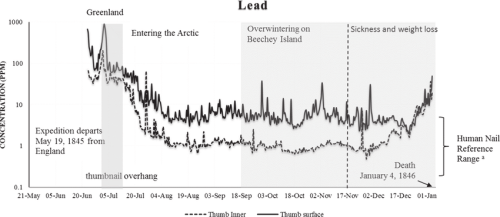
His nails told us so. And that wasn’t the only information they decided to divulge. Because of these findings, scientists could figure out when his sickness began nearly down to the day. Not only that, but they also discovered that John Hartnell had a very severe zinc deficiency.

‘Hartnell’s time machine’ as it was nicknamed became an incredible source for vital clues to the mysteries posed by the Beechey Island trio. The spike at the end of the chart shows the point that Hartnell’s body began to break down and essentially devour itself for one last effort at keeping itself alive. What this revealed was that Hartnell’s illness was practically a flash in the pan; he’d only really been sick for about a month and a half before his death. How did such a dramatic downturn occur?
So far, it seems like a combination of bad genes and that little demon of a zinc deficiency. John Hartnell’s autopsy reports revealed a whole slew of issues from a sprained ankle to a compacted vertebral disc (which would have been painful). It was clear he had lived a hard and active life, with the wear and tear showing on his very bones. The zinc deficiency’s symptoms would have manifested as weight loss, fatigue, poor wound healing, night blindness, and an increased risk of infection. The last symptom in that last may point the most damning finger at what finally killed John Hartnell. If he had a zinc deficiency as severely as it appears, his immune system would have been compromised and he wouldn’t have been able to fight off infection as well as some of his comrades.
Not only that, but lining up historical hints adds another sinister factor to the list.
In 1853, an exhumation attempt was carried out on his grave under the auspices of Sir Edward Augustus Inglefield of the HMS Isobel and his physician, Dr. Peter Sutherland (the group that put the pickax through his arm). One letter refers to the body as:
“perfectly preserved by the intense cold, exhibited no trace of scurvy or other malignant disease, but was manifestly that of a person who had died of consumption, a malady to which it was further known that the deceased was prone.” (Sir Roderick Murchinson, Royal Geographic Society, 1853)
Again: “known that the deceased was prone.” Someone apparently knew or believed that John Hartnell had previously been consumptive. Not only that, but plying a Maidstone newspaper brought up another point:

John Hartnell’s father, also named Thomas, died from a ‘lingering illness’. While there are multiple possibilities as to what this illness was, it lines up nicely with both the historical record and the clues in Hartnell’s body. It’s possible he was ill with tuberculosis prior, had his immune system compromised by his zinc deficiency, and had his previous illness exacerbated by Arctic conditions.
And all this was learned from one mummy.
While this doesn’t solve the deaths of every member of the Franklin Expedition, the findings at Beechey Island provided incredible insight into their lives and deaths, and may have opened a door into further understanding.
‘God have mercy on the frozen man’
The forensic results of the exhumations were astounding in themselves, but the cultural impact can’t be understated. The world was taken by the images of Torrington, Hartnell, and Braine. Torrington in particular had his image splashed across magazines and newspapers, becoming the quintessential poster boy of the Expedition. He haunted no lack of dreams (mine included, circa age 7) with his gaunt face and hazy, half-lidded eyes. One might say something about a man straddling the precipice of life and death, as it isn’t often that the dead look at you.
As said, the trio inspired a small but noticeable culture wave, with just a few key and oft-cited examples provided below:
- Iron Maiden’s ‘Stranger in a Strange Land’
- James Taylor’s ‘Frozen Man’
- Margaret Atwood’s short story ‘The Age of Lead’
Also, this particularly recognizable scene from AMC’s The Terror!
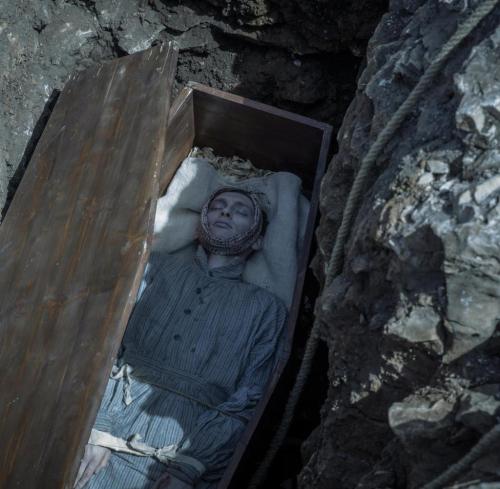
Paintings, sculptures, tattoos, poems, short stories, cosplay, dolls, and on and on! You could even argue that the discoveries on Beechey Island reignited new interest in the Franklin Expedition, creating a wave of discovery which eventually culminated in the discovery of the shipwrecks of Erebus in 2014 and Terror in 2016. Suddenly, the men of the Expedition were real, as tangible as you or me. People saw their faces, realized that these men were reaching across from the Victorian era into the 20th century. Sure, now they’re mostly condemned to Listverse-type categories of scariest mummies, but they’ve certainly drummed up emotional reactions in their time.
The Process
Now that we’ve covered the who, what, and when, it’s down to the how. How is a body preserved so well in ice and permafrost? The answer, my dear, is as simple as this picture.

It’s refrigeration on a natural level! Just as a refrigerator or freezer slows or completely stops bacteria from causing decay in food items (freeze your meats, my dudes!), permafrost and ice extends the same courtesy to anything buried in them. Of course, the conditions have to be specific! Other bodies found of the Expedition haven’t had even close to the same amount of preservation as the Beechey Island mummies. Wind, animals, and other natural processes have left a trail of skeletons rather than mummies. Clearly, something about depth of burial and level of protection is important as well.
Other ice mummies set to be covered include Ötzi the Iceman, and the Qilakitsoq mummies of Greenland. While there’s some variation as to their causes (glacial freezing and cold, dry air, respectively), the process is essentially the same. Cold stops naughty bacteria! The deep freeze kept the Beechey Island mummies from complete and utter decay, like freezing beef in an ice cube. Granted, if the mummies were ever exposed to warmer-than-freezing air for a pronounced length of time, they would eventually decay.
Conclusion
The Beechey Island mummies are an invaluable information source for questions about the final, mysterious fate of the men of the Franklin Expedition. Their bodies have provided incredible clues and beautiful insight into their lives as well as the lives of men like them. Not only that, but their cultural impact inspired a new wave of interest and the thought that the border between life and death is a surprisingly fragile one. While their initial appearance may be frightening or shocking to some, it’s important to remember that these were young men thrust into extraordinary circumstances. Their memory and impact is still felt to this day (which I hope makes them happy, wherever they are!).
If you have any questions, comments, or suggestions on this inaugural Mummy Monday, feel free to hit me up through the comments or DMs on Tumblr! It’s a lot of fun for me and I’m totally open to any and all comments about how I’m doing! Thanks for reading!

Comments
Post a Comment